Offsets are out. Onsets are in
An important, and heated, exchange during the first week of COP26 in Glasgow made one thing clear: The legitimacy of nature-based carbon offsets is in question as civil society grows more skeptical of corporate “net zero” pledges.
On a gloomy afternoon during the first week of the climate conference, a big crowd surrounded what was dubbed the Nature Zone stage for an important COP side event. The topic at hand was inclusive carbon markets. The event was delayed by a group of chanting protestors. Bloomberg reported that Greta Thunberg “interrupted” the proceedings but, in effect, she provided an important context for the session, setting up a conversation we’ve been needing to have for a long, long time.
Our civil society family has been divided, or even torn asunder, over the topic of Nature-based Solutions (NbS) for some time. Thanks to the moderating skills of the host Manuel Pulgar-Vidal, last-minute changes were made to the program to include interventions by several important civil society leaders, including Teresa Anderson from ActionAid and Jennifer Morgan from Greenpeace, who called carbon offsets a global scam. (You can watch the exchange at the 6:47:00 mark in the event video.)
The tension leading to this moment had been brewing in large part over the corporate capture of NbS, most notably by fossil fuel companies, pledging to achieve net zero emissions by providing funding to protect forests that might otherwise be cut down. If you’re not familiar with the lingo, this type of offset approach is called REDD+ (reduced emissions from deforestation and degradation).
The basic idea of REDD is to “Pay me to not cut down my trees.” The buyer of a carbon credit can deduct the emissions that theoretically would have been released from their carbon balance sheet, arguing they prevented inevitable emissions from occurring. The producer of the credit, which can be a government, not-for-profit, company or investment bank that “owns” the carbon rights of a particular plot of forest, gets paid and some of this funding goes to protect the forest where the credit was sourced. The biggest problem with this scheme is that it makes achieving net zero too cheap and too easy, providing an incentive to delay the necessary and more costly process of phasing out fossil fuels and transitioning to renewable energy.
Amid an accelerating climate crisis, this is a problematic pathway for any company to claim carbon neutrality. But when it comes to fossil fuel companies making these claims, the irony is unbearable … Are the very same corporations responsible for the catastrophic impacts of climate change, including the collapse of forests ecosystems due to prolonged drought and fire, are now framing themselves as the good guys, the champions of the forest?
Are the very same corporations responsible for the catastrophic impacts of climate change, including the collapse of forests ecosystems due to prolonged drought and fire, are now framing themselves as the good guys, the champions of the forest?
This came to a head a few weeks before COP26 at an oddly timed TED Countdown conference in Edinburgh focusing on climate solutions sponsored by Shell, BP and other fossil fuel companies. During one session, the climate activist Lauren McDonald sobbing, calls out the CEO of Shell on stage, describing him as “evil” and hypocritical for expanding fossil fuel production while simultaneously pledging to become a net zero company. It’s absolutely brutal to watch, and powerful.
Suffice it to say the REDD+ program specifically, and nature-based solutions more broadly, have been shunned by the vast majority of Indigenous rights groups, civil society organizations and climate activists — really all but a handful of larger NGOs like World Wildlife Fund, The Nature Conservancy, and Conservation International, who see REDD as a pragmatic way to get at least some desperately needed funding to help threatened forests.
Morgan pointed out during the Nature Zone event that we’ve had decades to fix the many problems with REDD and we’ve never managed to do so. These problems include double-counting, where both the buyer and the jurisdiction of the credit claim it as a reduction; additionality, would this deforestation have happened in the first place?; leakage, maybe the loggers just move to the next forest over; benefit-sharing, does any of the money actually go to communities on the ground?; legacy credits, old credits that were never retired and therefore shouldn’t count as real mitigation and supplementarity, a limit to the amount you are allowed to offset.
After COP, negotiators aimed to work out the complex rules for Article 6, which is the section of the climate convention dealing with carbon markets and other forms of finance for climate mitigation. In the late hours of the Glasgow climate talks, some breakthroughs were finally made, building upon a declaration made by over 100 countries the week prior to end deforestation by 2030. The Science Based Targets Initiative (SBTi) came out with long-awaited recommendations on net zero commitments, including a 5 to 10% limit on offsetting. Mark Carney himself, the co-chair of the Glasgow Financial Alliance for Net Zero (GFANZ), issued a sort of mea culpa stating that offsets should be used only as a last resort to neutralize “residual emissions,” a big change from statements made just a few months prior.
So, on the heels of COP26, where do we stand now on NbS and carbon offsets? Here are my top takeaways on where I think many climate movement leaders, human rights coalitions and members of civil society are generally headed on this topic.
Market-based offsets face fierce opposition
The social license for nature-based offsets, which I define here as “avoided emissions” or REDD+ offsets, has effectively been revoked by civil society. For as many COPs as I can remember, we would always see protestors carrying “No REDD” signs, but it feels different this time around. Given the urgency of the climate crisis, we simply need something better than REDD+ to fund the protection of forests at scale. The process of putting REDD credits on the market is enormously cumbersome and expensive, and there are significant human rights issues to consider.
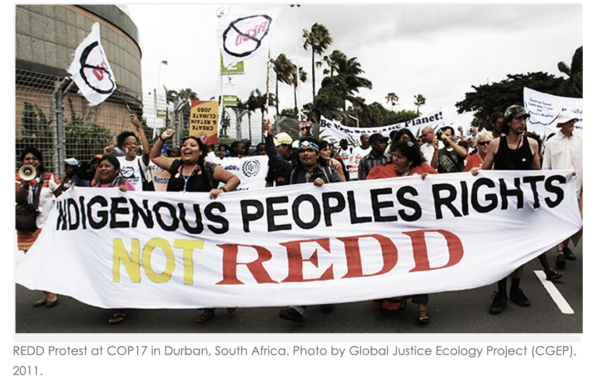
REDD Protest at COP17 in Durban, South Africa. Photo by Global Justice Ecology Project (CGEP), 2011.
Indigenous rights activists have warned of land grabs or “carbon grabs” — where governments invoke Article 6 to justify the weakening of land tenure rights for Indigenous peoples. And while the text of the convention now formally identifies the need for human rights safeguards, the myriad of unresolved technical problems and the newfound popularity of REDD+ amongst fossil fuel companies, billionaires and corporations jumping on the net zero bandwagon, means that civil society will only get more fiercely resistant to offsets. The context has also now changed. World leaders just agreed to phase out deforestation by 2030. If we take that at face value, then post-2030 this means there should be no more emissions to avoid, and therefore no more REDD+. Is REDD dead? Not just yet … but its days are numbered.
Carbon Removal is necessary –– we need “onsets” not offsets
The Intergovernmental Panel on Climate Change’s (IPCC) sixth scientific Assessment Report (AR6), with its revised carbon budget, has made it clear that it’s impossible at this point to achieve the goal of limiting global temperature rise to 1.5 C without a huge investment in nature-based carbon removal. My organization One Earth funded a landmark scientific study “Achieving the Paris Climate Agreement Goals” (APCAG), which found that even with the fastest renewable energy transition imaginable — reducing emissions by two to three billion tonnes of CO2 annually — we would still need to remove about 400 billion tonnes of legacy CO2 emissions from the atmosphere for a good –– 67% –– chance of limiting to 1.5 C.*
This is technically feasible through four forestry pathways — reforestation, replanting of forests on 350 million hectares of degraded land; forest restoration, allowing natural and protected forests to regrow; sustainable forest management, cutting fewer trees; and afforestation, trees on agricultural land.
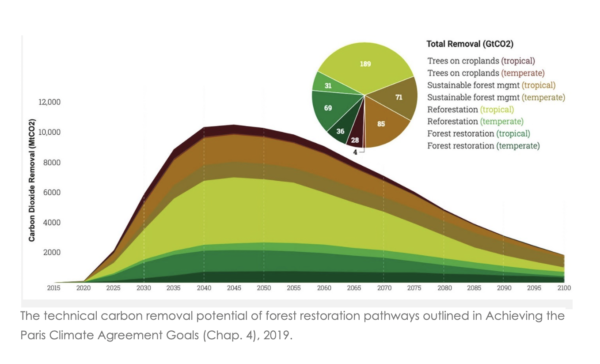
The technical carbon removal potential of forest restoration pathways outlined in Achieving the Paris Climate Agreement Goals (Chap. 4), 2019.
Because of the higher costs associated with restoration, and the fact that carbon accumulation can be more easily measured and attributed through remote sensing –– satellite-based optical, infrared and radar photography –– nature-based carbon removal is better suited for market mechanisms. Julio Friedmann at Columbia University calls these “onsets” in contrast to offsets. In carbon onset projects, degraded land is restored, resulting in additional sequestration of carbon from the atmosphere. These projects are easier to develop and can be structured to directly benefit local communities who receive funding for carbon removal and in many cases gain buffer areas for agroecological cultivation, which in turn supports rural livelihoods.
The U.N. in 2021 launched the “Decade of Restoration” with the goal of fulfilling the Bonn Challenge and restoring 350 Mha of degraded land worldwide, but we’re still in the early days. Progress has been slow, and a recent assessment by the German Environment Agency indicates approximately half of Bonn pledges are earmarked for tree plantations, which would not result in additional sequestration of carbon. Other reports have found large failure rates in tree planting efforts and warn that costs are much higher than the “dollar per tree” that is often advertised by restoration organizations. For these projects to have longevity they need the active participation of the people who live in these landscapes, and they must be developed within a social justice framework to ensure projects directly benefit local communities. That means more investment sustained over a longer period of time.
Net zero needs to be 95% “real zero”
In 2021 we saw enormous pushback to companies making ambiguous net zero pledges. Part of the reason was a lack of clarity and social consensus around the most crucial of all questions — how much should a company or government be allowed to offset as part of their net zero pledge? This is called supplementarity, a concept that was introduced in 1997 under the Clean Development Mechanism (CDM) of the Kyoto Protocol. Over the past year, Nigel Topping and leaders of the SBTi met with stakeholders in every sector to arrive at a top-level recommendation that was finally released at COP26: The default for a Paris-aligned 2050 net zero target should be 95% in gross emissions reductions, with a 5% allowance for “neutralization.”
A neutralization is an external activity paid for by a company that results in the direct removal of carbon from the atmosphere. This is in contrast to a “compensation” — a carbon offset such as a REDD credit (conveniently colored red in the chart below). A paper recently put out by the Climate Land Use Alliance (CLUA), authored by Nathaniel Keohane and Frances Seymour explains this concept in greater detail. The new SBTi standard does allow certain hard-to-abate sectors, e.g. cement, to use more neutralization credits than other sectors, but the general guidance for these sectors seems to be no more than 10% to 15% in removals to achieve net zero by mid-century, which is well within with the technical potential of carbon removal through forest restoration.
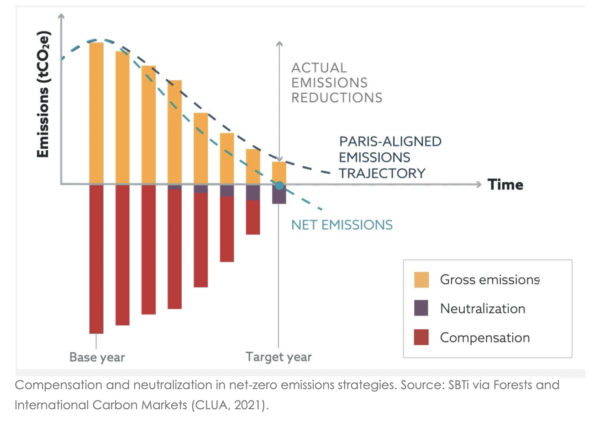
Compensation and neutralization in net-zero emissions strategies. Source: SBTi via Forests and International Carbon Markets (CLUA, 2021).
The new carbon budget in AR6 makes it clear that the entire world needs to achieve net zero emissions by 2055 for a 50% chance of keeping warming to 1.5 C or below. For a large company emitting say 40 million tCO2 per year today, this guideline would require them to directly reduce their emissions by roughly 20 million tonnes within the next ten years, to just 2 million tonnes by mid-century with any residual emissions neutralized through direct carbon removals. By 2050, it is expected that these removal credits could cost $100 per tonne or even more. So there will be a big incentive for each company to work hard to get closer and closer to “real zero” as quickly as possible.
In this new standard, before 2050 only the residual emissions from a Paris-aligned energy transition should be compensated through voluntary carbon offsets. Say, for example, the company described above decides instead to make a net zero by 2040 pledge. A Paris-aligned commitment would require them to directly reduce their emissions by about 80% in 2040. They could voluntarily offset only the remaining 20%, and a portion of this should represent additional carbon removals, aka neutralizations. The method is a little complicated, but it succeeds in clearly defining what a company can and cannot claim regarding its net zero pledge.
Thousands of companies have now committed to net zero emissions by 2050, and hundreds more to net zero by 2040, which is in line with a good 67% chance of limiting global temperature rise to 1.5 C. Now that we have some clear guidance on the limits to offsets in these pledges, this should be celebrated as a good thing. But it will be up to civil society, governments and even investors to hold companies to account. Companies, especially big polluters, will need to be pressured to immediately get on track to reduce their gross emissions in line with the Paris Climate Agreement.
Companies, especially big polluters, will need to be pressured to immediately get on track to reduce their gross emissions in line with the Paris Climate Agreement.
Non-market mechanisms need to be developed
One of the complaints of the authors of the CLUA paper is that the SBTi approach prefers financing of carbon removal over funding for existing forests via REDD+ credits. They make a well-justified case that standing forests are much more valuable than restored forests, both from a carbon perspective and from a biodiversity perspective. Natural forests harbor 80% of the world’s biodiversity and store more than a trillion tonnes of carbon (Soto-Navarro et al., 2020). The last thing anyone wants to do is to reduce the paltry amount of funding currently directed to the protection of our forests. But we have to ask ourselves, after decades of trying and failing to scale REDD offsets as a viable mechanism to protect forests globally, shouldn’t we look for something better?
CLARA put out a great paper in advance of COP26 dissecting the problems with offsets and market-based mechanisms, memorably titled “Release the Hostage.” The paper makes the case for a renewed focus on Article 6.8 in the convention, which calls for non-market mechanisms to fund nature at scale. After decades of deliberations and multiple U.N. conventions, we’ve never as a society figured out how to solve the most fundamental of problems — our global economy currently doesn’t value the critical role that forests and other ecosystems play in our global economy. The terrestrial carbon sink dutifully absorbs one-quarter of our global CO2 emissions every year, but this enormous ecosystem service goes almost wholly uncompensated.
A newly published paper, Roe et al. 2021, finds that three-quarters of cost-effective land-based mitigation potential is found in developing countries (10.7 GtCO2e annually). Even at a low price of $25 per tonne for nature-based CO2 mitigation, that should be something on the order of $250B per year paid to developing countries. We’re never going to get there through the carbon markets. Currently, we’re at about $250M per year in payments for nature-based carbon credits. Maybe this will scale to a billion or two, but to get to $250B per year we need big, bold ideas. Some are proposed in the CLARA paper.
Economists identify $100B+ in annual funding sources for finance of natural carbon sinks. Source: “Release the Hostage” (CLARA, 2021).
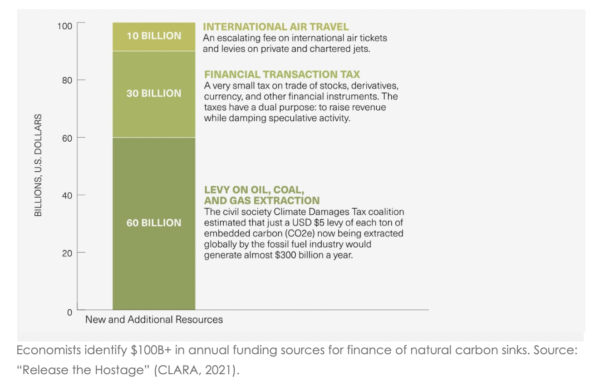
These new ideas include a globally agreed $1 to $5 per tonne levy on new fossil fuel development, which would generate $60 to $300 billion per year. Other ideas include results-based payments, financial transaction micro-taxes, air travel and ocean shipping fees, utilization of Special Drawing Rights held by International Monetary Fund (IMF) member countries, and other methods. The CLARA argument is compelling: We’re haggling over a Gordian knot of complex carbon trading rules when we should be looking at the bigger picture — our need to permanently fund the forests and ecosystems that make life on Earth possible.
It’s time to take the B.S. out of Nbs
In the very final hours of negotiations at COP26, there was an important language change in Article 6, replacing the term “nature-based solutions” (NbS) with “protection, conservation and restoration of nature.” This was due in large part to civil society pushback on NbS and the lack of formal definitions about the measures encompassed by the term and how they should be accounted for. The Nature4Climate coalition does clearly describe a broad portfolio of NbS measures — ranging from avoided deforestation (aka REDD) to reforestation and wetlands restoration to better manure management and rice farming practices, which reduce methane emissions. The aforementioned Roe et al. paper, supported by Nature4Climate, lays out the most comprehensive global assessment of NbS options to date.
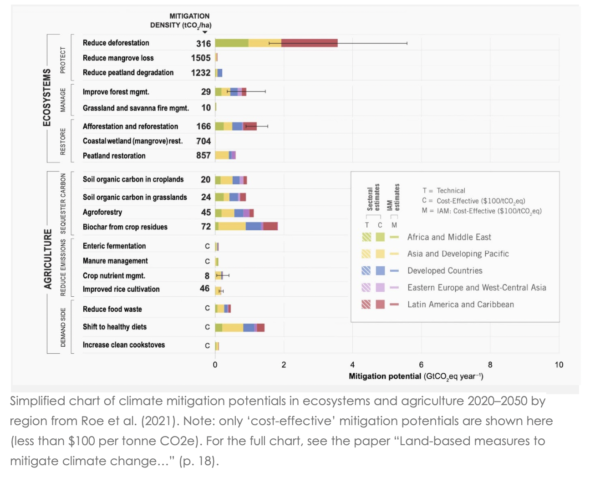
Simplified chart of climate mitigation potentials in ecosystems and agriculture 2020–2050 by region from Roe et al. (2021). Note: only ‘cost-effective’ mitigation potentials are shown here (less than $100 per tonne CO2e). For the full chart, see the paper “Land-based measures to mitigate climate change…” (p. 18).
In the analysis, Forest & Ecosystem Mitigation is the first of two broad groupings, covering the protection, conservation management, and restoration of nature now referenced in Article 6. The second grouping covers a wide array of measures related to agriculture and food systems, including demand-side reduction of food-related emissions. These estimates go a long way in allaying fears about NbS. But there is still work to be done to unpack some of these pathways if the climate movement is to coalesce around a common understanding of the important, but confined, role of land-based climate mitigation in achieving the goals of the Paris Agreement.
Bioenergy with Carbon Capture should not be included in any analysis regarding nature-based solutions.
How to do that? Here are a few recommendations. For starters, Bioenergy with Carbon Capture (BECCS) should not be included in any analysis regarding nature-based solutions. At best, BECCS provides carbon-neutral biomass energy. Energy is expended to log trees, which would otherwise be absorbing carbon, burn them, then chill and compress the resulting CO2 so that it can be pumped, sometimes over significant distances, to underground geological vaults. Unfortunately, the Roe et al. paper continues to reify this scheme as a viable climate solution, identifying 15 GtCO2 in “cost-effective” BECCS versus just 35 GtCO2 for reforestation. Reforestation, if done properly, is far less expensive, requiring almost no energy inputs. And once established, a new forest is the gift that keeps on giving, providing numerous co-benefits including continued sequestration of carbon for a century or more, a factor which is not incorporated into the Roe analysis. Note that I deleted BECCS from the above chart.*
Second, we need to be a lot more nuanced about reforestation. The Roe paper, like many others, lumps together myriad different approaches to planting trees and restoring forests. Afforestation — planting trees on croplands and rangelands — has wildly divergent costs and failure rates than reforestation, which can include numerous different approaches based on the forest biome. The paper also misses a powerful opportunity to allow degraded forests to naturally regenerate, which has a theoretical potential of about 100 GtCO2 in carbon removal through 2100 at an extremely low cost per APCAG, described above.
Lastly, as is highlighted by the CLARA paper, we need to acknowledge that there is an entire U.N. convention dedicated to the protection of forests and ecosystems — the Convention on Biological Diversity (CBD), which includes every country except Andorra, South Sudan and the United States. Shouldn’t the CBD be the venue for countries to establish protection and conservation goals, rather than the UNFCCC? Certainly, if a country makes a commitment under the CBD post-2020 Global Biodiversity Framework and dedicates funding to implement it, that country should be able to incorporate the carbon benefits of such a pledge in its NDC commitment under the U.N. climate convention. But after decades of unresolved problems around forest-based REDD offsets, it might be time to retire the idea that avoided destruction counts as a “climate solution.”


